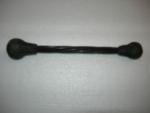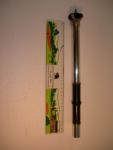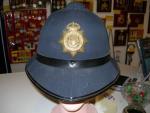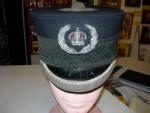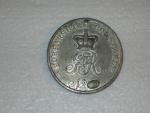-
Posts
13,225 -
Joined
-
Last visited
-
Days Won
22
Content Type
Profiles
Forums
Blogs
Gallery
Events
Store
Everything posted by Mervyn Mitton
-
Brian - I have some photos of the Staffordshire 'noddy' helmet and will post them in a day or so. Meanwhile, I think your posts have been very interesting and worthwhile - not enough is known about the County Forces. I have been trying to remember what is famous about the Staffordshire knot - if lovers each pull an end does it getter tighter ,or come loose ? Mervyn
-
Dear Craig - I thought you might be Met. - can I be 'cheeky' and ask your rank , you've obviously got a few years service behind you? When I was at HB, I leased a flat from the Crown Estate - just the other side of Victoria Park - it was unfurnished and as you know those don't happen today. The old manageress of the estate like the idea of a uniform in the area - she also gave me a relic sword - two handed sword from the Crusades, found in Cyprus and possibly Richard 1st. period. Like a fool I gave up the lease a few years ago , when I could no longer climb stairs - we live and learn. Mervyn
-
Known as a 'life preserver' many people carried these for protection in the 19thC. In the 18th.C swords were worn but, these had gone out of fashion - certainly by Victorian times - however, crime had not and the streets were very dangerous places.Men carried a variety of weaponry in case of attack - from pocket pistols ; sword canes ; bludgeons ; flails and these life preservers. They were usually made by sailors for extra income and the centre could be made from a variety of things - the main requirement being that it had flexibility to strike with extra force. This one has three pieces of whalebone - and is very 'springy' - both ends are a lead ball covered with intricate knotting - which is why the sailors were able to make them. They are fairly common and come in different sizes - I will show pictures of the other personal protection pieces at another time - however, it is interesting that two of them gave rise to common English expressions.
-
I am feeling guilty that most recent posts have been on the British police - so,attached is an early truncheon , staff or, night stick from the States (not sure what they're called now ?). When I bought this some 35 years ago it had a label saying it was carried by the Boston Police and dated to the 1880's. I know the the Eastern freeboard cities copied a lot of British equipment in the middle and last part of the 19th.C - They wore a helmet - often grey in colour - frock coats - and these heavy truncheons. There was a tradition of officer's showing their skill, by knotting the rope around the handle - using this they would then 'throw' the truncheon head first at the pavement and then catch the rebound with the rope (which they were still holding). The one shown here would not have been for everyday use, but reserved for ceremonial parades. I hope this will encourage some response about equipment in the US - past and present. Mervyn
-
Hi. 1900 was the year of manufacture - I would say the likelihood of it being used in South Africa is high - but we would have to eastablish which unit it was issued to. Value wise - a complete one , in good condition, is about ?200/300. I am afraid without a scabbard you will be lucky to get ?100. Best wishes - our temp. at present is 28c - in the shade - on most days , so, a little of your weather would be welcome. Mervyn
-
I was in 'H' Div. stationed at Bethnal Green - I nearly resigned when I was first posted - I had delusions of grandeur and wanted 'B' and Knightbridge - in fact I greatly enjoyed the East End and found the real East Enders genuinely nice people. Where are you stationed ? My favourite Comm. was Sir Robert Marks - he was put in to shake up the Met. and he certainly did that. Change is inevitable, but we 'oldies' don't have to agree - read Brian's comment above. Best wishes Mervyn
-
I should have added that this is not the correct scabbard - it should be all metal and with two suspension rings. Mervyn Mitton
-
One other point to Robin's reply, is that many of our colonial police forces were para-military and with the climate were often in khaki. South African police ranks for officers were based on their military counter parts - however, after 1994 (Govt.change) they had senior officers from the Met. advise them and they now follow the British style. Mervyn
-
Dear Brian - a nice helmet and with good enamelling. I quite understand why you keep it behind glass - everyone, and their dog, wants to put on a British helmet. When I was in the Met. I was a home-beat officer - nowdays, I think they call them Community Officers. I had an area with some 20000 people and it included 4 schools - if I gave talks, the kids always wanted to play with the helmet, so, how did I get around this - bearing in mind that even in the '70's head lice were a problem - I used to take any spare one from the locker room... Should you be interested to add to your Staffordshire collection , I have a rare 'Noddy' helmet I would be willing to sell for a fair price. This helmet has re-inforcing and a leather chin strap that is in two parts. For a short period Velocette motor cycles were introduced for Beat patrols. The officers didn't have to have full training and it was thought they would make getting around easier. They were not a success and didn't last long, which makes this rare - I also have one for the Met. - and yes, the name does come from Enid Blyton. Look forward to seeing your other pieces. Mervyn
-
Paul These are very good examples - and always remember - the RUC guarded their equipment more vigilantly then the mainland forces - so these are very collectable. I used to have two rare badges for the Belfast Harbour Police,not sure where they are now. Thankyou for sharing - now, with your influence - get everyone else to post - I think in two days we've exceeded last year !! Mervyn
-
This is the head of the Magistrate's tipstaff for Shadwell. A lovely George 111 crown - hallmarked for 1802 and all silver - made by a famous silversmith of his day. Should anyone be interested I could go into more details with the early public offices. Out of interest -the first time the word POLICE was used officially, was in the Dublin Police Act - of, I think, 1792. Mervyn
-
I broke my promise - sorry !! However, it's taken me three days - and a computer expert - to find out how to download pictures - so, my motto - strike while I can remember.. This is not the rarest piece in the collection - many of those have now gone - however, it is an important part of our British police heritage. The first Public Office was set-up at Bow Street in 1748 and ran under the Fielding Brothers (of Tom Jones fame) for many years - it included the Bow Street Mounted Patrol, the Bow Street Runners and of course, the magistrate, three constables and their helpers. They also had cells and a matron for the women prisoners. Bow Street was so succesful that in 1792 a further 7 Public Offices were established in different parts of London. One of them was at Shadwell - which is immediately to the East of the Tower of London and included a very rough part of the East End. This tipstaff has the hallmark for 1802 and is engraved 'CONSTABLE OF SHADWELL' . One has to understand that a magistrate had different functions in those days and was also directly in charge of his police officers (if you have seen 'Treasure Island' you will remember the magistrate arrives to take charge with his constables) - so, although he is referred to as Constable, it is the magistrate they mean. Anything to do with the early Offices is rare and valuable - about ?4000 ! Will try to show the top in next post. Mervyn
-
Will Very similar - although the civic guard also had military jobs - i.e. guarding power stations , docks etc.. We also have a reserve for the S.A.P. -which is still active, but I must look-up when it was formed. My problem is that I carry this info. in my head and at my age that's not always wise !!! Mervyn
-
Dear Will Nice to see a complete uniform - outside of museums they just don't seem to exist. I am pretty sure that this helmet is the 1st. pattern - slightly taller than the 2nd. - if it says 'POLITIE' and not 'POLISIE' it is the pre-1926, or 1st. Now... if everyone else will also post something, I won't feel like I'm staging a coup !!! Mervyn
-
http://gmic.co.uk/uploads/monthly_03_2009/post-6209-1237724871.jpghttp://gmic.co.uk/uploads/monthly_03_2009/post-6209-1237724871.jpg Last one - promise !! During the 1st.WW so many Police joined the Services that they were left only with small numbers. The War Reserve Police were formed - in nearly every town - the big problem was that they had no uniforms. Each man was issued with a truncheon, an identifying lapel badge and an arm band - saying he was a constable. These varied from force to force and are now very collectable - and unlike some items are not too expensive. Sometimes they made the badge to hang from a button. After the war each constable - at least in the midlands - receive a commemorative truncheon with a transfer of the town arms - these are highly collected. Mervyn p.s. can anyone delete the SA helmet where the wording didn't come out ?
-
The SA Police were formed in 1913 - from a mix of small forces, many of which had sprung-up after the Boer War. There were two patterns of helmets - the first similar to a British helmet in shape and with a similar helmet plate. This is the 2nd. pattern - dating fom the 1930's to just after the 2nd. WW. Because of the SA habit of giving items like this to the gardener, not many have survived - however, the plates are available. Mervyn
-
Reading through past Police Posts , I was surprised to see that for the whole of last year there were only 12 ! We really are the 'forgotten' service - until you need one, that is - and then there is never one around !! I have no wish to look as if I'm trying to take over this forum - however, if I post a number of different items it might spur others on to show pieces from their collections. I will 'do' another 2 or 3 and see what reaction ? This lovely cap is the pattern for Inspectors and Superintendents - although this one is a Supt's. - they date from the 1890's to about the 1st WW. Prior to this the army and officers of police were wearing the horrible little pillbox - this sat on the side of the head and to hold it on the strap always had to be down. Basically, they made it a little larger and added a peak - also, for ranks of Supt. and above , they added bullion on the peak. This particular cap has a King's crown - so, is for Edward V11 (1902-1910). Being collectors we always ask - How much ? About ?150/200 - it is rare, so perhaps a little more. Mervyn
-
Dear Robin Thankyou for replying - I knew your name immediately, but associated it with PICA (Police Insignia Collectors Assoc.). I actually use some of your books to help with identification in the shop - so, I am most impressed. I cannot pretend to have a great knowledge of German collecting - we always keep some good pieces in the shop - but,I find the collectors know more than I do on this subject. With the Police Acts of 1839 and 1856 many Forces have had their 150th. in recent years and I was pleased to see that they have taken their history more seriously and most have prepared and issued Force Histories to commemmorate the event. I have seen many of them and they add greatly to our knowledge - unfortunately, although policing affects all of our lives , it is the forgotten service. I think this is partly because our equipment is not glamorous and really hasn't changed much since 1829. I thought you might like to see this constable's badge of office for Forfarshire ( where is it exactly?). Dates back to George 1V (1820-1830) and is cast in pewter - since it covered a County there was more than one required - so, they put a blob of solder on and impressed the constable's number. The badge would have been around his neck on a ribbon - cheaper than a tipstaff, but , it makes it rare. Mervyn




